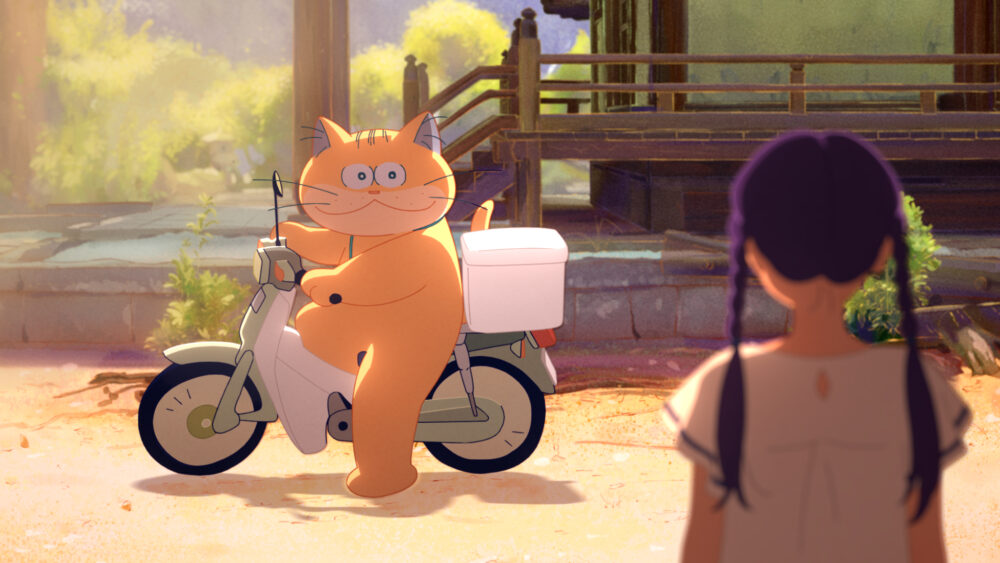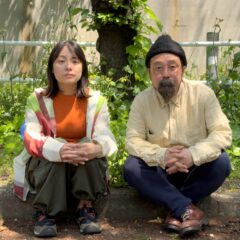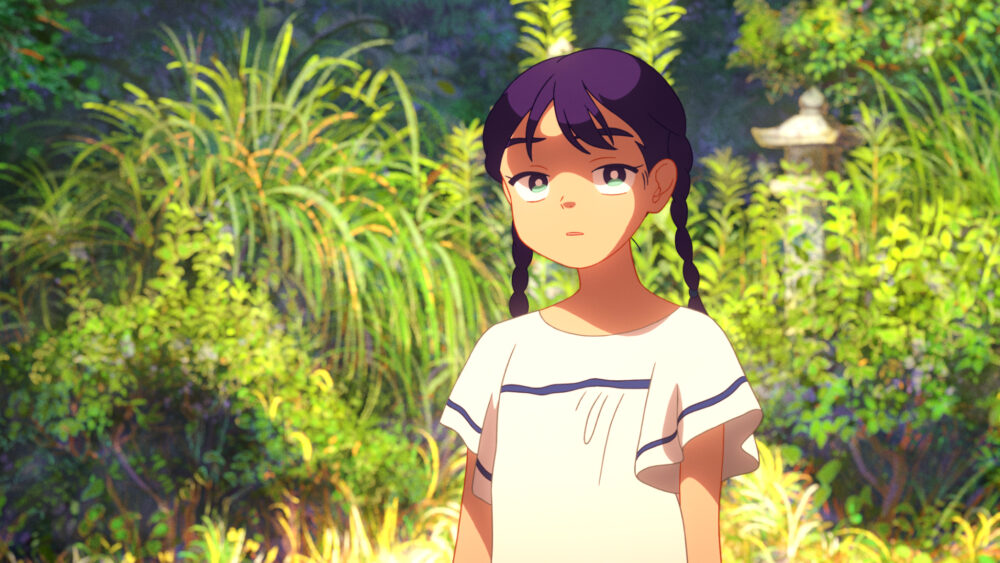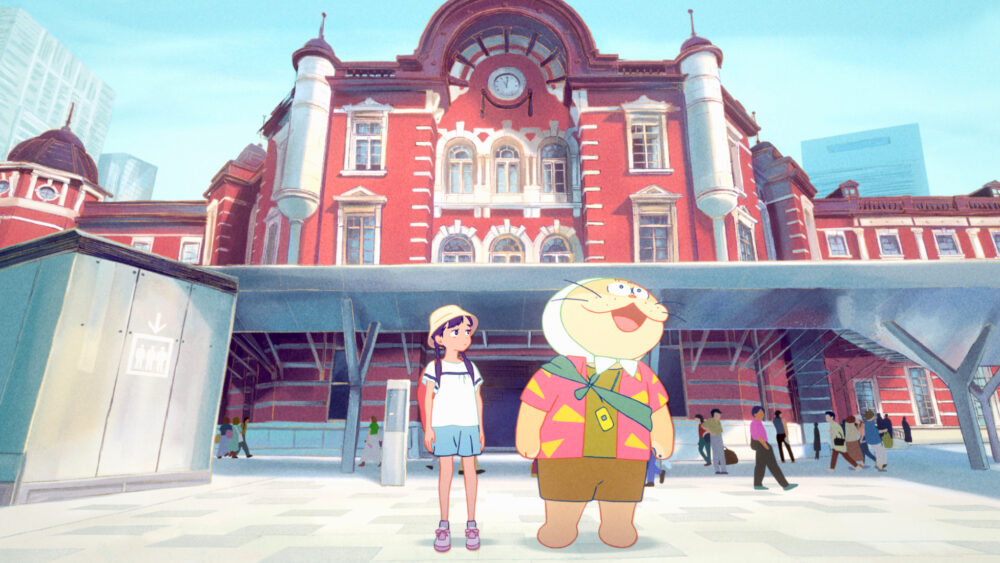|
Getting your Trinity Audio player ready...
|
[adrotate banner=”1124″]
Any true fan of Japan’s amazing manga and anime world knows that when young people travel to the countryside to live with their relatives, they are bound to meet magical and ethereal spirits and characters. So, it’s not surprising that when Karin, the 11-year-old heroine of the new animated feature Ghost Cat Anzu, is sent to live with her monk grandfather, she comes across a feline spirit who becomes her special guardian.
The eagerly anticipated movie is directed by Yoko Kuno and Nobuhiro Yamashita, based on a popular manga by Takashi Imashiro, whose previous credits include Hard-Core and Carib Song. Produced by Japan’s Shin-Ei Animation and France’s Miyu Productions, the film will be distributed in North America by indie powerhouse GKIDS.
The directors were kind enough to answer a few of our questions between the film’s debut at the Cannes Directors Fortnight and its unspooling at Annecy this year. Both Kuno and Yamashita have been fans of the original manga for quite some time. Kuno happened to meet the film’s producer, Keiichi Kondo, one day, and he casually mentioned that he was thinking about creating an animated feature with Yamashita, who is best known as a live-action director. “The idea intrigued me, so I eagerly expressed my interest in being involved in the project,” she recalls.

A Sweet Deal
“I had been considering the idea of making a short live-action adaptation for some time,” adds Yamashita. “Then, about eight years ago, Keiichi Kondo, the producer, approached me and proposed this project to make a feature-length, rotoscoped animation, co-directed with Yoko Kuno.”
It was an offer he simply couldn’t resist! “I felt very comfortable with the relaxed, carefree atmosphere of the original work and the distinctive sense of morality and justice characteristic of Takashi Imashiro, the original author,” he says. “Moreover, I found the sense of the distance between the characters and the ghosts fascinating.”
Kuno adds, “In the manga, there’s a consistent portrayal of moments where a character is on the verge of defeat or struggles to overcome adversity. While straightforwardly depicting such situations is already cool, Imashiro infuses them with a touch of pathos and melancholy, which I found deeply compelling. It’s this sincerity in capturing people that resonated with me.”

‘I want the audience to witness the character of Karin, a not-so-good girl, alongside Anzu, a lazy ghost cat with actions and emotions that wouldn’t typically make them protagonists, and see how their unbalanced outlook on life shines through the animation.’
— Director Yoko Kuno
Because the original manga was created for a children’s magazine, the trials of life are central to the story. “As a result, it creates a unique blend of themes suitable for both adults and children,” explains Kuno. “Furthermore, in Imashiro’s manga, all characters possess a certain level of cuteness, yet Anzu, as a cat, exudes a charmingly awkward kind of cuteness, which I find particularly endearing.”
Work on the script began in 2017, but the project almost came to a halt several times. Then the live-action shoots took place in the summer of 2022, followed by animation work commencing toward the end of that year. Full-length production continued until this spring. “The decision to fully pursue the project was solidified around 2021, marking the beginning of our step-by-step journey toward its realization,” recalls Kuno. “It wasn’t until the French production company Miyu expressed interest in the project that significant progress was made,” notes Yamashita. “The project really began to take off after we made a three-minute pilot version. From there, we proceeded with live-action filming, and after a year and a half of animation work the project was completed.”
The idea to use rotoscope technology to produce the animation was introduced by Kondo. “Given that both Yoko Kuno, who is excellent at rotoscoping, and I, as the live-action director, happen to both be fans of the original work, I believe that the best approach to creating this film is through our collaborative efforts, beginning from the live-action filming stage and extending through to the rotoscope animation process,” notes Yamashita.
Kuno also believes that the most effective way to bring the direction to life would be to shoot actors’ performances as live-action sequences. “I love live-action films myself, and the authenticity of Yamashita’s direction possesses a unique allure that animators may struggle to replicate,” she notes. “Therefore, collaborating with him on an animation project, utilizing rotoscoping, was imperative to me.”
Miyu was in charge of all the background art for the film, as well as the coloring of the characters and compositing design. Shin-Ei Animation handled the animation part of the drawing and also the actual character coloring and compositing. “I believe the tone of the work became unique due to the subtle differences between Japan and Europe in terms of the feeling of sunlight and the sense of color,” says Yamashita. “I realized how interesting it could be because of the co-production.”
The project marked many firsts for both the directors. “Given my limited experience in the field, I wasn’t particularly well versed in the fundamentals of Japanese animation production. But I didn’t feel too overwhelmed or confused,” she says. “However, I think that the teams at Miyu Productions and Shin-Ei Animation might have felt somewhat out of their comfort zone, since the project was so different from their usual work. I can only express my gratitude to the staff on both sides for their dedication and collaboration until the very end.”
Yamashita chimes in. “The live-action production process, from preparation to filming, was handled by the same team as usual, so I did not notice any significant differences. The transition to animation provided me, as a director, a more objective perspective on the work and most importantly, I found myself enjoying the final result more than usual when I watched it, which was a different experience compared to the past.”
An Arduous Assignment
According to Kuno, the biggest challenge for the animation team was the length of many of the scenes. “In typical Japanese animation, a scene usually lasts around six seconds, but in Ghost Cat Anzu, most scenes are approximately 12 seconds long, with some extending to over 30 seconds or even a minute. Even with live-action footage, animators faced a tremendous workload and reviewing these lengthy scenes was time-consuming and arduous. I doubt I will undertake another feature-length animation with such extended scenes in the future!”
Both directors hope the film will be full of pleasant surprises for audiences around the world. “It is not a flashy story, nor is it a film with sharp messages,” admits Yamashita. “However, I believe the film conveys a universal emotion that resonates across all ages. Such emotions can transcend national borders. Anyway, the happiest thing for me is to make people laugh and fall in love with Anzu.”
As Kuno points out, “I’ve always noticed that many characters in Japanese animation, particularly the female ones, tend to be portrayed as more serious and well behaved compared to characters in live-action films. In our film, one of the main characters, Karin, doesn’t fit the typical mold of a serious, good girl, nor is she a complete delinquent. I hope to see more animated films featuring such ordinary, not-so-perfect girls who are commonplace in Japan. I want the audience to witness the character of Karin, a not-so-good girl, alongside Anzu, a lazy ghost cat with actions and emotions that wouldn’t typically make them protagonists, and see how their unbalanced outlook on life shines through the animation, and I hope everyone enjoys it!”
Ghost Cat Anzu is competing at the Annecy Festival this month. GKIDS will release the movie in North American theaters later this year.




![Ghost Cat Main Ghost Cat Anzu [Shin-Ei Animation / Miyu Prod.]](https://www.beta.animationmagazine.net/wordpress/wp-content/uploads/Ghost-Cat-Main-696x392.jpg)



